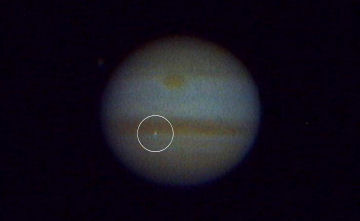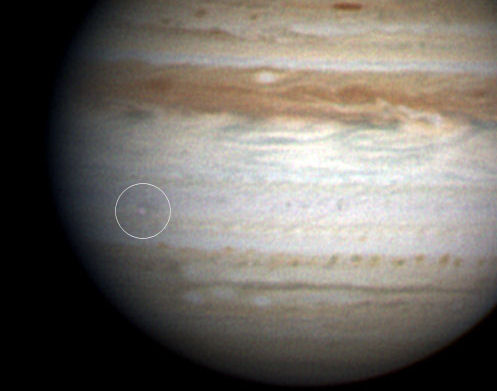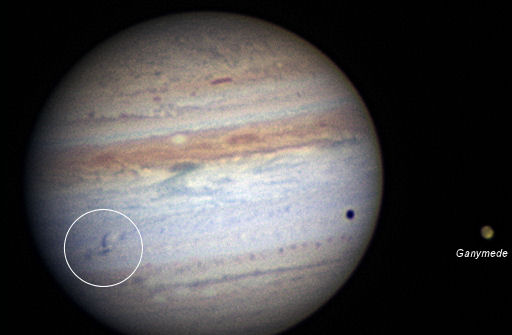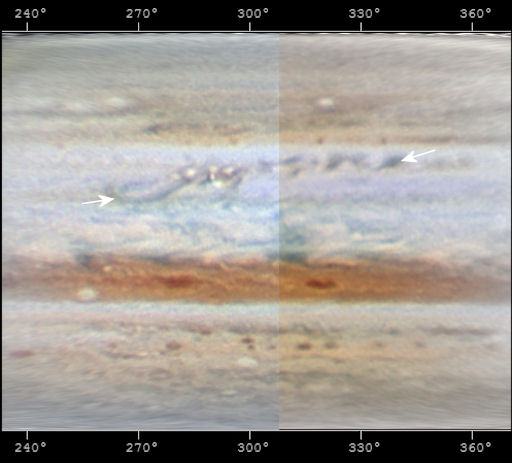May. 10, 2010 | 15:22 PDT | 22:22 UTC
Via Daniel Fischer's Tweet about a blog entry by Astro Bob I learned of something which should be obvious to anyone who has trained even a rather small telescope on Jupiter over the past few weeks: one of its iconic stripes is just plain gone.

Over a period of a year, one of Jupiter's two main dark belts -- the dark stripes most visible in amateur telescopes -- has faded completely away. The South Equatorial Belt (SEB) is gone, leaving just the north belt (NEB) viewable in small telescopes. Credit: Anthony Wesley
Astro Bob explains in more detail, remarking: "Jupiter with only one belt is almost like seeing Saturn when its rings are edge-on and invisible for a time -- it just doesn't look right." But, apparently, this is an event that happens rather more frequently than the Saturnian equinox, once every 3 to 15 years.
The photos above are from Anthony Wesley, the same guy who discovered the impact scar on Jupiter last year; but you don't need to be as fabulous an astrophotographer as Wesley to see this for yourself. You do, however, need to get up early; Star Walk (my iPhone astronomy app of choice) tells me Jupiter rises around 3:30 a.m. right now. If you don't feel like getting up early, just check out Wesley's website for more wonderful photos of Jupiter.
Bron: planetary.org
quote:Global warming of course.
quote:Ons gedrag heeft overal invloed op, sterker nog, het feit dat jij nog steeds auto rijdt heeft er nu voor gezorgt dat Jupiter nog maar 1 riem heeft. Nu de admosfeer van Jupiter, straks de admosfeer van de Aarde.
We moeten hier heel snel weg! Starship Enterprise, here we come!
quote:Aan de andere kant.Op donderdag 13 mei 2010 13:38 schreef cherrycoke het volgende:
waar is die grote rode vlek gebleven?
quote:Te veel van die SUV "Aso" bakken aldaar..
In het vervolg eerst eens kijken of t artikel al gepost is?
Slotje, dank u
[ Bericht 16% gewijzigd door ExperimentalFrentalMental op 19-05-2010 09:49:20 ]
quote:Big Mystery: Jupiter Loses a Stripe
May 20, 2010: In a development that has transformed the appearance of the solar system's largest planet, one of Jupiter's two main cloud belts has completely disappeared.
"This is a big event," says planetary scientist Glenn Orton of NASA's Jet Propulsion Lab. "We're monitoring the situation closely and do not yet fully understand what's going on."
Known as the South Equatorial Belt (SEB), the brown cloudy band is twice as wide as Earth and more than twenty times as long. The loss of such an enormous "stripe" can be seen with ease halfway across the solar system.
"In any size telescope, or even in large binoculars, Jupiter's signature appearance has always included two broad equatorial belts," says amateur astronomer Anthony Wesley of Australia. "I remember as a child seeing them through my small backyard refractor and it was unmistakable. Anyone who turns their telescope on Jupiter at the moment, however, will see a planet with only one belt--a very strange sight."
Wesley is a veteran observer of Jupiter, famous for his discovery of a comet hitting the planet in 2009. Like many other astronomers, he noticed the belt fading late last year, "but I certainly didn't expect to see it completely disappear," he says. "Jupiter continues to surprise."
Orton thinks the belt is not actually gone, but may be just hiding underneath some higher clouds.
"It's possible," he hypothesizes, "that some 'ammonia cirrus' has formed on top of the SEB, hiding the SEB from view." On Earth, white wispy cirrus clouds are made of ice crystals. On Jupiter, the same sort of clouds can form, but the crystals are made of ammonia (NH3) instead of water (H20).
What would trigger such a broad outbreak of "ammonia cirrus"? Orton suspects that changes in global wind patterns have brought ammonia-rich material into the clear, cold zone above the SEB, setting the stage for formation of the high-altitude, icy clouds.
"I'd love to send a probe in there to find out what's really going on."
Indeed, Jupiter's atmosphere is a mysterious place which would benefit from exploration. No one knows, for instance, why the Great Red Spot is red—or what has sustained the raging storm for so many years. Neither does theory explain why the twin equatorial belts are brown, nor why one should vanish while the other remains. "We have a long list of questions," says Orton.
This isn't the first time the SEB has faded out.
"The SEB fades at irregular intervals, most recently in 1973-75, 1989-90, 1993, 2007, 2010," says John Rogers, director of the British Astronomical Association's Jupiter Section. "The 2007 fading was terminated rather early, but in the other years the SEB was almost absent, as at present."
The return of the SEB can be dramatic.
"We can look forward to a spectacular outburst of storms and vortices when the 'SEB Revival' begins," says Rogers. "It always begins at a single point, and a disturbance spreads out rapidly around the planet from there, often becoming spectacular even for amateurs eyeballing the planet through medium-sized telescopes. However we can't predict when or where it will start. On historical precedent it could be any time in the next 2 years. We hope it will be in the next few months so that everyone can get a good view.
"I'll be watching every chance I get," says Wesley. "The revival will likely be sudden and dramatic, with planet-circling groups of storms appearing over the space of just a week or so."
Indeed, says Orton, "anyone could be the first to spot the return of the SEB."
quote:In het astronomie topic wordt het nieuws geplaatst.... hier kun je erover doorpratenOp woensdag 19 mei 2010 09:42 schreef ExperimentalFrentalMental het volgende:
Het Astronomie topic #4
In het vervolg eerst eens kijken of t artikel al gepost is?
Slotje, dank u
zonder het astronomie topic te "vervuilen"....
(tvp voor als ik helderder ben morgen
quote:Nope.... de zon stond ertussen...Op vrijdag 21 mei 2010 01:24 schreef 08gnoT. het volgende:
Wat raar! En dat hebben ze niet gedurende het proces zien gebeuren?
(tvp voor als ik helderder ben morgen)
quote:Tussen de aarde en Jupiter?
quote:Dat kan volgens jou niet?
Jupiter verliest opnieuw een streep
Er is geen enkele wetenschapper die weet waarom, maar Jupiter heeft opnieuw een van zijn prominente strepen verloren waardoor de zuidelijke hemisfeer van de planeet ongebruikelijk blank geworden is. Je leest het goed: opnieuw een streep verloren. Het is namelijk niet de eerste keer dat Jupiter geobserveerd werd zonder zijn donkere band op de zuidelijke helft van de planeet. Het gebeurde al eerder in 1973-1975, 1989-1990, 1993 en 2007.

De verschijning van Jupiter wordt meestal gedomineerd met twee donkere strepen in de atmosfeer, eentje in de noordelijke en eentje in de zuidelijke hemisfeer. Recente beelden van amateurastronomen laten zien dat de zuidelijke streep - in termen van astronomen: de South Equatorial Belt - verdwenen is. En planeetwetenschappers - zoals bijvoorbeeld Glenn Orton van het NASA Jet Propulsion Lab - hebben geen flauw idee waarom.
Op het einde van 2009 merkten wetenschappers dat de bruine wolkenband aan het vervagen was, maar toen kwam Jupiter te dicht bij de zon te staan om van op aarde verder te kunnen observeren. Toen Jupiter in april 2010 uit de verblindende zonnestralen te voorschijn kwam was de zuidelijke band nergens meer te bespeuren. Het is echter niet de eerste keer dat de donkere streep op de zuidelijke hemisfeer niet thuis geeft. De bruine band was in 1973 ook niet op het appel toen de ruimtesonde Pioneer 10 (ook wel Pioneer F genoemd) als eerste close-up beelden van Jupiter schoot.

De strepen van Jupiter lijken donker, omdat bleke hoge wolken die in de atmosfeer van Jupiter kunnen voorkomen daar niet aanwezig zijn. Zo krijgen donkere, lagere wolken de kans om zich te tonen. Wanneer we Jupiter observeren kijken we dus eigenlijk naar de verschillende wolkenlagen van de planeet. Het is dus heel goed mogelijk dat de op dit ogenblik 'verdwenen' donkerbruine streep gewoon schuil gaat onder een hoger en bleker wolkendek.
Op aarde bestaan witte cirruswolken (ook windveren of vederwolken genoemd) uit ijskristallen. Op Jupiter kunnen zich ook witte cirruswolken vormen, maar daar bestaan de kristallen uit ammoniak in plaats van uit water.

Het is niet duidelijk waarom er zich soms witte cirruswolken vormen op de zuidelijke hemisfeer van Jupiter. Het verdwijnen van de zuidelijke streep valt wel samen met wijdverspreide - doch mysterieuze - veranderingen op Jupiter. Zo veranderen andere strepen van kleur en verschijnen er vlekken in de atmosfeer. Er zou dus op Jupiter eigenlijk niets meer dan een gigantisch meteorologisch megafeest aan de gang zijn.
(Grenswetenschap)
Gewoon, om het goede voorbeeld te geven.

Dat is in de laatste 13 maanden dusver de 3de keer dat een amateur astronoom een meteoriet inslag waarneemt op Jupiter eerdere waarnemingen vonden plaats op Juli 19, 2009, and Juni 3, 2010
link to video op spaceweather.com
quote:Maar goed dat die stofzuiger er is...Op maandag 23 augustus 2010 13:09 schreef mediacurator het volgende:
Een amateur astronoom Masayuki Tachikawa uit Kumamoto city, Japan, maakt video-recording van schijnbaar een meteoriet inslag is op Jupiter
[ afbeelding ]
Dat is in de laatste 13 maanden dusver de 3de keer dat een amateur astronoom een meteoriet inslag waarneemt op Jupiter eerdere waarnemingen vonden plaats op Juli 19, 2009, and Juni 3, 2010
link to video op spaceweather.com
quote:stofzuiger? van die afstand lijkt het klein maar is waarschijnlijk de kracht van 1000'den atoombommenOp maandag 23 augustus 2010 20:40 schreef -CRASH- het volgende:
[..]
Maar goed dat die stofzuiger er is...
quote:Met stofzuiger meen ik dat Jupiter veel puin opvangt wat richting de zon/aarde komt.Op dinsdag 24 augustus 2010 12:59 schreef mediacurator het volgende:
[..]
stofzuiger? van die afstand lijkt het klein maar is waarschijnlijk de kracht van 1000'den atoombommen
quote:Ok nu begrijp ik het, ook de athmospheer buiten de dampkring rondom de aarde schijnt zo vol met spacejunk te zitten dat het in de toekomst met toenemende mate een risico zou vormen voor de ruimtevaart, maar dat is een ander onderwerpOp dinsdag 24 augustus 2010 14:03 schreef -CRASH- het volgende:
[..]
Met stofzuiger meen ik dat Jupiter veel puin opvangt wat richting de zon/aarde komt.
quote:Dat bekijk ik o.a.liveOp dinsdag 24 augustus 2010 14:22 schreef mediacurator het volgende:
[..]
Ok nu begrijp ik het, ook de athmospheer buiten de dampkring rondom de aarde schijnt zo vol met spacejunk te zitten dat het in de toekomst met toenemende mate een risico zou vormen voor de ruimtevaart, maar dat is een ander onderwerp
en op Space junk google earth
[ Bericht 3% gewijzigd door -CRASH- op 24-08-2010 15:34:30 ]
Last night, the atmosphere over Australia settled into a state of rare, crystal-clear transparency -- and it did so directly above the observatory of world-famous astrophotographer Anthony Wesley. The result was a picture of Jupiter that some onlookers are calling the finest-ever by an amateur astronomer. "On a scale of 1 to 10, the seeing was a 12," says Wesley. "Now I know what it must be like to see the giant planet from space."

www.spaceweather.com
quote:Hij verliest en krijgt er weer een bij ongeveer elke 15-20 jaar.Op dinsdag 24 augustus 2010 15:24 schreef speknek het volgende:
Is er echt helemaal niks bekend over waarom dit gebeurt? De rode vlek lijkt er nog wel te zijn, dus de lagere luchtlagen zijn dan nog wel rood?
Waarom dit precies gebeurt is volgens mij niet bekend.
Earlier this year when Jupiter's great South Equatorial Belt (SEB) vanished, researchers urged amateur astronomers to be alert for its eventual return. The SEB had come and gone before, they noted, and the revival was something to behold. Alert: It might be happening now. After months of quiet in Jupiter's south equatorial zone, a white plume is surging through the cloudtops where the SEB should be. Christopher Go of the Philippines took this picture on Nov. 9th:

It might not look like much, but this is how a revival of the SEB begins--a small disturbance in the upper atmosphere heralds a much larger profusion of spots and swirls bursting forth around the whole circumference of the giant planet. Amid the confusion, Jupiter's vast brown stripe emerges.
Subsequent observations by astronomers in the United States, Japan, and the Philippines not only confirm the plume, but also show it brightening rapidly. Indeed, as Nov. 11th unfolds, it is the single brightest spot on Jupiter in wavebands ranging from infrared to ultraviolet.
"This plume is so energetic that we can confidently expect it to develop into the SEB Revival," says John Rogers, director of the Jupiter section of the British Astronomical Association. "The SEB Revival is usually spectacular, so we can expect impressive and rapidly changing disturbances over the next 3 months."
Experienced planetary photographers are encouraged to monitor developments. If events proceed apace, the Revival could become visible to novices using small backyard telescopes, so stay tuned.
www.spaceweather.com
Dat vraag ik me net ook af.quote:
Als die fabriek niet geraakt is door die meteoriet uiteraard.quote:Op vrijdag 12 november 2010 22:47 schreef RetepV het volgende:
Die aliens daar hebben gewoon de fabriek tijdelijk stopgezet om periodiek onderhoud te plegen. Vandaar geen rook meer.
Misschien een soort van inversie-laag doorbroken, waardoor er een enorme supercell onstaan is op Jupiter.quote:Op donderdag 11 november 2010 21:31 schreef -CRASH- het volgende:
JUPITER'S MISSING STRIPE, RETURNING?
Earlier this year when Jupiter's great South Equatorial Belt (SEB) vanished, researchers urged amateur astronomers to be alert for its eventual return. The SEB had come and gone before, they noted, and the revival was something to behold. Alert: It might be happening now. After months of quiet in Jupiter's south equatorial zone, a white plume is surging through the cloudtops where the SEB should be. Christopher Go of the Philippines took this picture on Nov. 9th:
[ afbeelding ]
It might not look like much, but this is how a revival of the SEB begins--a small disturbance in the upper atmosphere heralds a much larger profusion of spots and swirls bursting forth around the whole circumference of the giant planet. Amid the confusion, Jupiter's vast brown stripe emerges.
Subsequent observations by astronomers in the United States, Japan, and the Philippines not only confirm the plume, but also show it brightening rapidly. Indeed, as Nov. 11th unfolds, it is the single brightest spot on Jupiter in wavebands ranging from infrared to ultraviolet.
"This plume is so energetic that we can confidently expect it to develop into the SEB Revival," says John Rogers, director of the Jupiter section of the British Astronomical Association. "The SEB Revival is usually spectacular, so we can expect impressive and rapidly changing disturbances over the next 3 months."
Experienced planetary photographers are encouraged to monitor developments. If events proceed apace, the Revival could become visible to novices using small backyard telescopes, so stay tuned.
www.spaceweather.com
Ik vraag me af of daar ook onweer op gaat zitten. (er werden al ooit bliksemflitsen waargenomen op Jupiter)
Think of the turmoil at the sea surface just before a massive submarine emerges from depth. Something like that is happening on Jupiter. A turbulent plume is breaking through the giant planet's cloudtops in the south equatorial zone, heralding the emergence of ... what? Scroll past this Nov. 14th photo from astrophotographer Paul Haese of Glenalta, South Australia for further discussion:

The plume, circled in Haese's photo and known to astronomers as the "SEB Revival Spot," is a sign that Jupiter's South Equatorial Belt (SEB) is about to return. The great brown belt disappeared earlier this year, leaving Jupiter without one of its signature stripes. No one knows where the SEB went, although some researchers have speculated that it sank beneath high altitude clouds and might now be bobbing back to the top.
Christopher Go of the Philippines first noticed the Revival Spot on Nov. 9th. At first it was small and white and required careful astrophotography to detect. Only five days later, it is expanding rapidly and darkening; soon, it could become visible to novices in the eyepieces of backyard telescopes. Stay tuned for updates.
www.spaceweather.com

The return of Jupiter's lost stripe (the South Equatorial Belt) is proceeding apace. At least three energetic plumes are breaking through the cloudtops of Jupiter's south equatorial zone, shown here in a weekend photo from Brian Combs of Buena Vista, Georgia. Researchers believe these plumes herald the emergence of the globe-straddling belt, mysteriously absent for nearly a year.
Jupiter krijgt zijn streep terug
AMSTERDAM - Dit voorjaar verdween een van de opvallende donkere wolkenbanden in de atmosfeer van Jupiter. Nieuwe NASA-opnamen wijzen erop dat de band zich aan het herstellen is.

© NU.nl/Allesoversterrenkunde.nl
Begin november ontdekte een Filippijnse amateurastronoom een opvallend heldere plek op de plaats waar normaal gesproken de zuidelijke equatoriale wolkenband van Jupiter te vinden is.
Volgens Amerikaanse astronomen is dat het begin van het herstel van de donkere streep die doorgaans ten zuiden van evenaar van de planeet te vinden is. De oorzaak van het verdwijnen van de wolkenband lijkt te liggen bij het tijdelijk wegvallen van de droge valwinden die het betreffende gebied vrijhouden van hoge, heldere wolken van ammoniakijs.
Hierdoor werd de lager gelegen donkere wolkenband tijdelijk aan het zicht onttrokken. Het was niet voor het eerst dat dit gebeurde. Zo eens in de paar decennia herhaalt de zuidelijke equatoriale band - en alleen dŪť - dit kunstje. Naar de oorzaak van deze abrupte verandering wordt nog gezocht.
© NU.nl/Allesoversterrenkunde.nl
(nu.nl)
The revival of Jupiter's South Equatorial Belt (SEB), missing for nearly a year, is now well underway. The roiling, turbulent disturbance that heralds the brown stripe's full return stretches almost halfway around the giant planet. "Here is a projection map showing the revival on Nov. 29th," says amateur astronomer Wayne Jaeschke of West Chester, Pennsylvania. Note the region bracketed by arrows:

Here is a projection map showing the revival of Jupiter's SEB, about three weeks after it began. The map is made from two frames RGB images taken about 50 minutes apart on Nov. 29 at 00:33 - 1:20 ut in pretty good seeing.
"I made the map by combining two pictures of Jupiter I took using my 14-inch Celestron telescope," says Jaeschke. "The disturbance has grown dramatically since it first appeared in late October." Indeed, it is now so large that even novice observers are starting to notice it in the eyepieces of backyard telescopes.
The spreading disturbance is not the SEB itself. Instead, it is thought to be a progressive clearing of high clouds that will eventually reveal the brown stripe hiding below. When the SEB finally returns, Jupiter will have two brown stripes again and the planet's appearance will return to normal. Meanwhile, amateur astronomers are encouraged to monitor the revival.

Wayne Jaeschke
Image taken:
Nov. 29, 2010
Location:
West Chester, PA, USA
Details:
Here is the revival in Jupiter's Southern Equatorial Belt, showing numerous bright storms and plumes of dark material extending across a significant portion of the hemisphere. It's grown dramatically over the past few weeks! C14 @ f/24.5 PGR Flea3 Astronomik RGB
[ Bericht 8% gewijzigd door -CRASH- op 01-12-2010 07:01:18 ]
Saturnus heeft sinds 13 December een storm.
13-12-2010

06-02-2011
